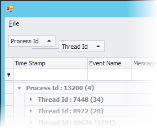This page refers to an older version of the product.View the current version of the online Help.
Personalization Server Log Viewer
In this section:
Interface Overview
Personalization Server Log Viewer provides a user interface to view and analyze log files from the Environment Manager Personalization Server.
The tool is compatible with Personalization Server log files in an ETL format only
For information on how to analyze endpoint log files, see Environment Manager Monitor.
Load a Log File
-
Select File > Open.
A file browse dialog displays.
-
Select an ETL log file and click Open.
Personalization Server Log Viewer loads the log file. The loading progress displays at the bottom of the dialog.
Export Logs
-
Select File > Export.
Select a format to export to. The following options are available:
- Excel
- CSV
- Text
- Rich Text
- Web Page
-
PDF:
A file save dialog displays
-
.Select an export location and click Save.
The current dataset is exported to the selected location.
Sort Columns
Right-click a column heading.
Select a sort order:
- Sort Ascending - Sort the data in ascending order.
- Sort Descending - Sort the data in descending order.
To clear the sorting, right-click the column heading and select Clear Sorting.
Filter Columns from Existing Values
This option displays all of the unique values for a field, such as all Thread IDs, from the open log file. Columns can be filtered by a specific value from the dataset.
-
Hover over a column heading and click the filter icon.
A list of unique values within the column displays.
-
Select a value on which to filter the selected column.
The data is filtered to show only entries that match the criteria.
To clear the filtering, right-click the column heading and select Clear Filter.
Filter Columns using Auto Filter Row
The Auto Filter Row displays above the dataset and allows columns to be filtered by entering basic filtering criteria.
- Right-click a column heading and select Show Auto Filter Row.:
- The Auto Filter Row displays below the column headings.
-
To filter a column, enter text into the Auto Filter Row.
The data is filtered to show only entries that match the criteria entered in the Auto Filter Row.
- To clear the filtering, right-click the column heading and select Clear Filter.
Filter Columns using Filter Editor
The Filter Editor allows conditions to be created to target specific data in the dataset. Use multiple expressions and nested Boolean operators to crate complex conditions.
-
Right-click a column heading and select Filter Editor.
The Filter Editor dialog displays.
- Edit the condition as required:
- Click a red Boolean operator, such as And to edit the operator or add a new condition group.
- Click a blue field name such as [Time Stamp] to change the field to match.
- Click a green operator such as Equals to edit the operator.
- Click either <enter a value> or a black value to enter a value.
Click
 to add a new expression to the condition.
to add a new expression to the condition.
- Click Apply to preview the filter.
-
Click OK.
The data is filtered to show only entries that match the criteria entered in the Filter Editor.
To clear the filtering, right-click a column heading and select Clear Filter.
Group Columns
Data can be grouped by one or more columns to create nested datasets.
-
Right-click a column and select Group By Box.
The Group By box displays above the column headings.
-
Drag a column heading into the Group By box. More columns can be dragged into the Group By box to create nested groupings.
The data is grouped by the fields specified in the Group By box.
To clear the grouping, right-click on the Group By box and select Clear Grouping.
Search Log Entries
-
Press Ctrl+F.
The Find Panel displays above the column headings.
- Enter a search term.
-
Click Find.
Rows containing text in any column that matches the entered search term are displayed.
To clear the search, click Clear in the Find Panel or close the Find Panel.
Command Line Interface
The Personalization Server Log Viewer tool also provides a command line interface. The following commands are available:
-
Open the user interface
EtwLogFileReader.exe -
Open an ETL log file in the user interface
EtwLogFileReader.exe C:\Logs\Input.etl -
Convert an ETL log file to text file
EtwLogFileReader.exe C:\Logs\Input.etl /export -
Convert an ETL log file to text file in a different output directory
EtwLogFileReader.exe C:\Logs\Input.etl /export:C:\Temp\Output.txt



